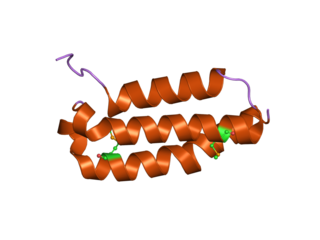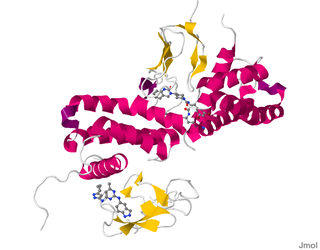Calcitonin gene-related peptide (CGRP) is a member of the calcitonin family of peptides consisting of calcitonin, amylin, adrenomedullin, adrenomedullin 2 (intermedin) and calcitonin‑receptor‑stimulating peptide. Calcitonin is mainly produced by thyroid C cells whilst CGRP is secreted and stored in the nervous system. This peptide, in humans, exists in two forms: CGRP alpha, and CGRP beta. α-CGRP is a 37-amino acid neuropeptide and is formed by alternative splicing of the calcitonin/CGRP gene located on chromosome 11. β-CGRP is less studied. In humans, β-CGRP differs from α-CGRP by three amino acids and is encoded in a separate, nearby gene. The CGRP family includes calcitonin (CT), adrenomedullin (AM), and amylin (AMY).

Adrenomedullin is a vasodilator peptide hormone of uncertain significance in human health and disease. It was initially isolated in 1993 from a pheochromocytoma, a tumor of the adrenal medulla: hence the name.
Receptor activity-modifying proteins (RAMPs) are a class of protein that interact with and modulate the activities of several Class B G protein-coupled receptors including the receptors for secretin, calcitonin (CT), glucagon, and vasoactive intestinal peptide (VIP). There are three distinct types of RAMPs in mammals, designated RAMP1, RAMP2, and RAMP3, each encoded by a separate gene.

Receptor activity modifying protein 1 is a protein that in humans is encoded by the RAMP1 gene.

Receptor activity modifying protein 2, also known as RAMP2, is a protein which in humans is encoded by the RAMP2 gene.

The neuromedin B receptor (NMBR), now known as BB1 is a G protein-coupled receptor whose endogenous ligand is neuromedin B. In humans, this protein is encoded by the NMBR gene.

Calcitonin receptor-like (CALCRL), also known as the calcitonin receptor-like receptor (CRLR), is a human protein; it is a receptor for calcitonin gene-related peptide.

5-hydroxytryptamine receptor 3A is a protein that in humans is encoded by the HTR3A gene.

Bradykinin receptor B1 (B1) is a G-protein coupled receptor encoded by the BDKRB1 gene in humans. Its principal ligand is bradykinin, a 9 amino acid peptide generated in pathophysiologic conditions such as inflammation, trauma, burns, shock, and allergy. The B1 receptor is one of two of G protein-coupled receptors that have been found which bind bradykinin and mediate responses to these pathophysiologic conditions.

P2Y purinoceptor 14 is a protein that in humans is encoded by the P2RY14 gene.

Neuropeptide FF receptor 2, also known as NPFF2 is a human protein encoded by the NPFFR2 gene.

Relaxin/insulin-like family peptide receptor 3, also known as RXFP3, is a human G-protein coupled receptor.

P2Y purinoceptor 4 is a protein that in humans is encoded by the P2RY4 gene.

Growth factor receptor-bound protein 14 is a protein that in humans is encoded by the GRB14 gene.

DNA-directed RNA polymerase III subunit RPC9 is an enzyme that in humans is encoded by the CRCP gene.

Interleukin 20 receptor, alpha subunit is a subunit for the interleukin-20 receptor. IL20RA is its human gene.

ADM2 is a protein that in humans is encoded by the ADM2 gene.

Probable G-protein coupled receptor 61 is a protein that in humans is encoded by the GPR61 gene.

GPR182 is a human gene which is an orphan G-protein coupled receptor.
Deborah Lucy Hay is a New Zealand academic. In 2022 she was elected a Fellow of the Royal Society Te Apārangi.


















